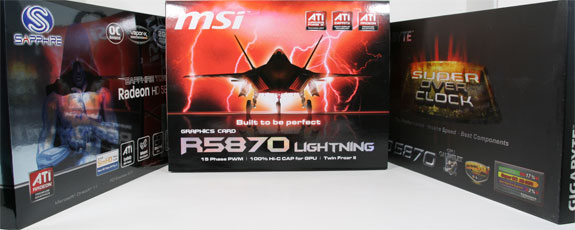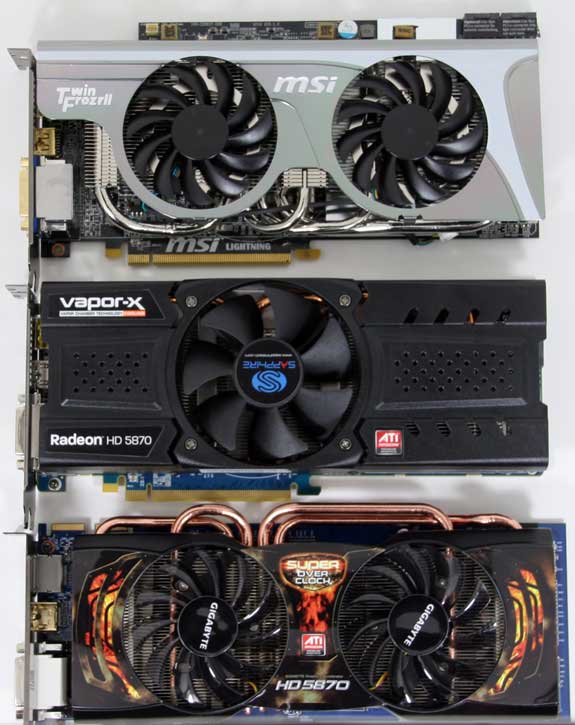Overclocked: Our Custom Radeon HD 5870 Roundup
by Ryan Smith on May 19, 2010 11:53 AM ESTFans of custom video cards have undoubtedly found themselves a bit disappointed with the Radeon HD 5800 series. Due to a perfect storm of low GPU yields from TSMC and NVIDIA’s late arrival with the GTX 400 series, the first 6 months for the 5800 series was nothing other than bonkers. AMD was selling GPUs to their partners as fast as they could come out of TSMC, and their partners were selling finished boards to OEMs and-end users alike as fast as they could be assembled. Even at prices over MSRP, the 5800 series flew off the shelves, leaving AMD’s partners with little-to-no supply of GPUs to tinker with. Custom 5800 series cards effectively took a 6 month vacation.
That wait finally came to an end in the Spring of 2010, as an increase in GPU supplies allowed AMD’s partners to catch their breathes and focus on their custom cards. With 6 months under their belts AMD’s partners were able to come up with a variety of designs for their custom cards, and today we’re going to be looking at a trio of custom Radeon HD 5870s: Sapphire’s Radeon HD 5870 Toxic 2GB, MSI’s Radeon HD 5870 Lightning, and Gigabyte’s Radeon HD 5870 Super Overclock.
| Sapphire 5870 Toxic 2GB | MSI 5870 Lightning | Gigabyte 5870 Super Overclock | |
| Core Clock | 925MHz | 900MHz | 950MHz |
| Memory Clock | 1.225GHz (4.9GHz data rate) GDDR5 | 1.2GHz (4.8GHz data rate) GDDR5 | 1.25GHz (5GHz data rate) GDDR5 |
| Frame Buffer | 2GB | 1GB | 1GB |
| Voltage Control | No | Yes (1.35v) | Yes (1.28v) |
| Price Point | $499 | $479 | $499 |
Custom cards are almost always interesting for a few different reasons. Often it’s a chance to see what AMD’s partners learned about a GPU over the preceding months and are trying their hand at producing something cheaper. Other times it’s throwing cost-efficiency out the window in the name of better components and coolers. And yet in other times it’s about producing a card that fills a specific niche, such as hardcore overclockers or users with cramped cases.
Today we’re looking at 3 such cards, each taking a different approach in their custom design. MSI’s Lightning is the overclocker and Sapphire’s Toxic is the build-it-better card, while Gigabyte’s Super Overclock attempts to straddle the line between the two by doing both at once. Ultimately however all 3 shoot for the same goal even if they go about it in different ways: maximizing performance.
Finally it shouldn’t come as a surprise that with all 3 cards designed to be superior 5870s that they command a superior price. At $480-$500, all 3 cards are solidly in the luxury category.












43 Comments
View All Comments
KayDat - Wednesday, May 19, 2010 - link
An interesting result...but looking at some other 5870 reviews, OC3D reviewed an XFX 5870 xXx edition ( http://www.overclock3d.net/reviews/gpu_displays/xf... ), which is an OC oriented card based off reference design, and they managed to get a 984MHz overclock, along with the cards stock 1300MHz memory. Would be interesting if you could take a look at that card as well.Nimiz99 - Wednesday, May 19, 2010 - link
on the page for overall OC results it readsSapphire Toxic 2GB: 600/1250
MSI Lighting: 940/1300
Gigabyte Super Overclock: 950/1325
i think the saphire should be 960
---
BTW, thank you for giving us a quick overview of the OC advantage over stock speeds. It's something I am always interested in to see if paying for the OC ability is worth it.
Great article
Earthmonger - Wednesday, May 19, 2010 - link
I was really hoping these OCs would conquer the stock GTX 480. I've been looking for a reason to NOT go nVidia this round. As a water cooler, noise and heat are irrelevant to me. Power is my only concern. 170w vs 190w at idle, and within 50w at load (Crysis)... I'm not sure that small of a difference is enough justification to buy a slower GPU.PS, in the test setup you list the NVIDIA GeForce GTX 260 Core 216, but have no results for it in any of the tests. Typo?
MadMan007 - Wednesday, May 19, 2010 - link
It looks to me like the power draw penalty for 2GB on the Sapphire card is ~25W. Is there something else like clock speeds that are somehow being factored in or was this just a mistake?BlendMe - Wednesday, May 19, 2010 - link
That's a 92mm not cm fan on the sapphire.Rick83 - Wednesday, May 19, 2010 - link
and 80 mm (again, not cm) on the MSI...BlendMe - Wednesday, May 19, 2010 - link
and on the Gigabyte as well...Ryan Smith - Wednesday, May 19, 2010 - link
If I'm going to be wrong, at least I'm going to be consistently wrong.marc1000 - Thursday, May 20, 2010 - link
LOL!!!!!every now and then, there is some joke here that makes me laugh... good article btw!
about the overcloks, it looks like a future re-spin of the cypress running at 1ghz could overcome the Fermi.... it would be fun to see a 2 billion transistor GPU running faster than a 3 billion one....
Voo - Thursday, May 20, 2010 - link
The thing is compared to Cypress Fermi overclocks exceptionally well, especially considering the fact that when it first appeared I don't think anyone thought it would. Seems like Fermi should profit a lot more from a die shrink than cypress, but let's see what NI brings to the table.